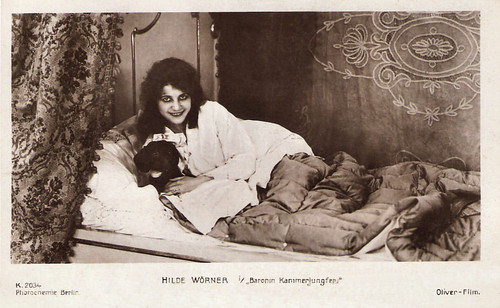
German postcard by Photochemie, no. K.2034. Photo: Oliver-Film. Publicity still for Baronin Kammerjungfer/Baroness Kammerjungfer (Leo Peukert, 1917).
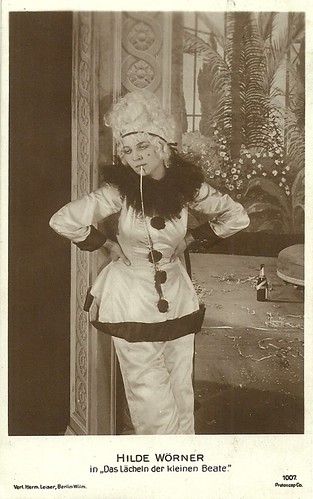
German postcard by Verlag Hermann Leiser, no. 1007. Photo: Protoscop Co. Hilde Wörner in Das Lächeln der kleinen Beate/The Smile of Little Beate (Georg Schubert, 1919).
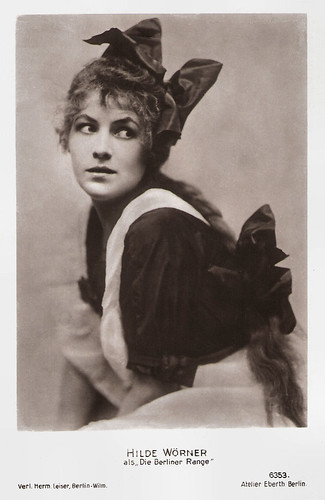
German postcard by Verlag Hermann Leiser, Berlin, no. 6253. Photo: Atelier Eberth, Berlin. Hilde Wörner in Die Berliner Range/The Berlin Urchin (Carl Müller-Hagen, 1919-1921).

German postcard by Photochemie, Berlin, no. K.3215. Photo: Alex Binder, Berlin.
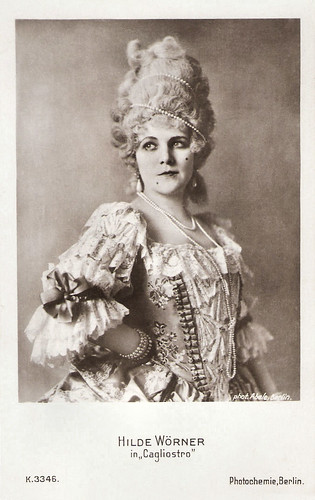
German postcard by Photochemie, no. K.3346. Photo: Abele, Berlin. Hilde Wörner in the German-Austrian coproduction Der Graf von Cagliostro (Reinhold Schünzel, 1919-1920).
The highest thing a film diva strives for
Hilde Wörner was born as Hilde Wörner-Lichtenstein in 1895. The place of birth is unknown.
At 16, Wörner began her stage career in Elberfeld (toady a part of Wuppertal). In 1912, Johannes Maurach brought her to the Stadttheater in Essen. Later followed engagements at the theatres of Oldenburg and Bremen.
In the late phase of the First World War, she reached Berlin, where she succeeded Lisa Weise in the operetta ensemble of the Berliner Theater. There she was the first soubrette.
Almost at the same time, Heinrich Bolten-Baeckers, director of the Oliver Filmgesellschaft, signed her for the cinema. Wörner made her film debut in the silent film Baronin Kammerjungfer/Baroness Kammerjungfer (Leo Peukert, 1917). She immediately had the status of a ‘series star’. "This is the highest thing a film diva strives for," said Wörner in 1919.
She specialised in the role of youthful salon ladies and played in both dramas and comedies. However, according to German Wikipedia, she was regarded as a mediocre actress. In 1919, Hilde Wörner founded the Filmproduktionsgesellschaft Wörner-Film in Berlin, which produced various feature films until 1923.
At that time, Wörner was married to the silent film director Carl Müller-Hagen, who directed many of her films, such as the six-part series Die Berliner Range/The Berlin Urchin (1919-1921) and the crime costume drama Moriturus (1920) with Max Landa, as the detective, Reinhold Schünzel in the title role, and Conrad Veidt as the criminal.
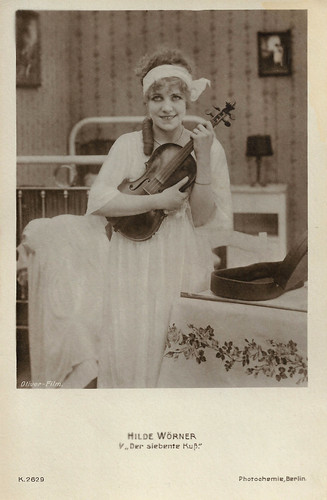
German postcard by Photochemie, Berlin, no. K. 2629. Photo: Oliver-Film. Hilde Wörner in Der siebente Kuß/The Seventh Kiss (N.N., scripted by Marie Luise Droop, 1918).
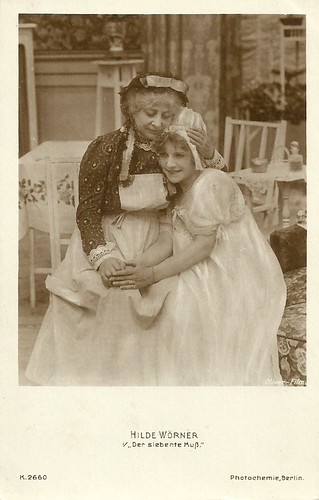
German postcard by Photochemie, Berlin, no. K. 2660. Photo: Oliver-Film. Hilde Wörner in Der siebente Kuß/The Seventh Kiss (N.N., 1918). Director unknown.

German postcard by Photochemie, Berlin, no. K. 2661. Photo: Oliver-Film. Hilde Wörner in Der siebente Kuß/The Seventh Kiss (N.N., 1918).

German postcard by Photochemie, Berlin, no. K. 2662. Photo: Oliver-Film. Hilde Wörner in Der siebente Kuß/The Seventh Kiss (N.N., 1918). The man next to Wörner may be Charles Willy Kayser, who plays the male lead in the film.

German postcard by Photochemie, no. K.3341. Photo: Anny Eberth, Berlin.
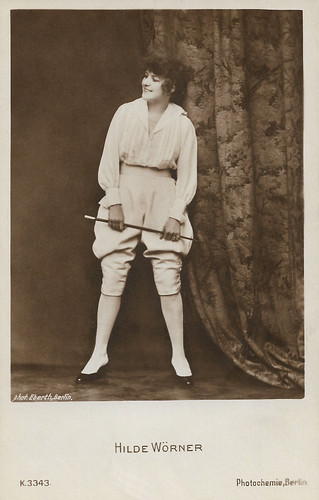
German postcard by Photochemie, no. K.3343. Photo: Anny Eberth, Berlin.
Ernst Lubitsch's last German film
In 1920, Hilde Wörner appeared in the Austrian-German production Der Graf von Cagliostro/The Count of Cagliostro (Reinhold Schünzel, 1920), in which director Reinhold Schünzel played the role of the eighteenth century Italian adventurer Alessandro Cagliostro opposite Anita Berber and Conrad Veidt.
With her small film company, she produced Russian director Dimitri Buchowetzki’s historical drama Danton (1921) with Emil Jannings as Danton and Werner Krauss as Robespierre. Based on the play Danton's Death by Georg Büchner, the film tells how during his reign of terror, Robespierre orchestrates the trial and execution of several of his fellow leading French revolutionaries including Georges Danton.
Wörner also produced his version of William Shakespeare’s Othello (Dimitri Buchowetzki, 1922), again with Emil Jannings and Werner Krauss.
At the side of Pola Negri, Wörner played the second female starring role in Die Flamme/The Flame/Montmartre (Ernst Lubitsch, 1923), which she also produced. It was Ernst Lubitsch's last German film before he moved to Hollywood.
Then Wörner retired from the film business and continued to work in the theatre. In 1926, she returned seen in a supporting role in Rosen aus dem Süden/Roses from the south (Carl Froelich, 1926), starring Henny Porten.
In 1930, she appeared in small parts in two sound films, the musical comedy Einbrecher/Burglars (Hanns Schwarz, 1930) with Willy Fritsch and Lilian Harvey, and the historical film Das Flötenkonzert von Sans-souci/The Flute Concerto of Sans-Souci (Gustav Ucicky, 1930) starring Otto Gebühr as Friedrich II (aka Frederick the Great). It was part of the popular cycle of Prussian films.
It was her last film appearance. Wörner married tenor Eduard Lichtenstein and performed with him at the Metropol Theater in Berlin. After the rise of the Nazis, the Jewish Lichtenstein and his wife moved to the Netherlands where they lived in Amsterdam. In the summer of 1933, she appeared in Kabarett der Prominenten, founded by Willy Rosen. She also played in Rosen’s comedy Der Chauffeur meiner Frau (My Wife's Chauffeur) in the Netherlands.
What later happened to her is little known, but she married the Dutch conductor Jan Koetsier. In 1949, she translated for him a musical play based on Frederik van Eeden’s play Frans Hals/Een vrolijk geval (Frans Hals – a cheerful case) into German.
Hilde Wörner passed away in 1963. She was 67.
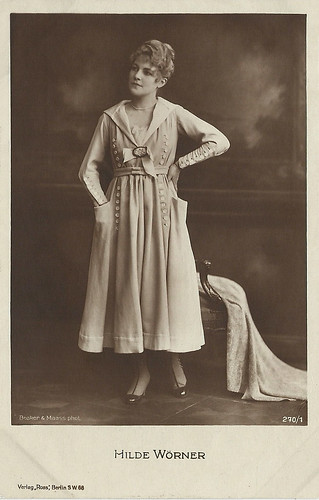
German postcard by Ross Verlag, Berlin, no. 270/1. Photo: Becker & Maass, Berlin. Collection: Didier Hanson.

German postcard by Ross Verlag, no. 270/2, 1919-1924. Photo: Becker & Maass.

German postcard by Ross Verlag, no. 270/3, 1919-1924. Photo: Becker & Maass.
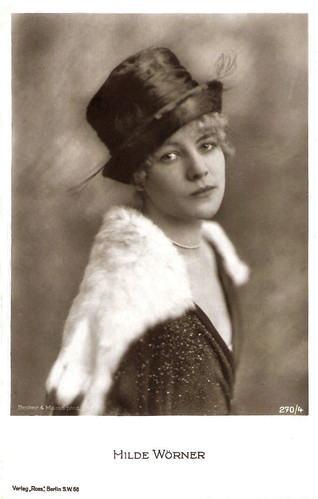
German postcard by Ross Verlag, no. 270/4, 1919-1924. Photo: Becker & Maass.
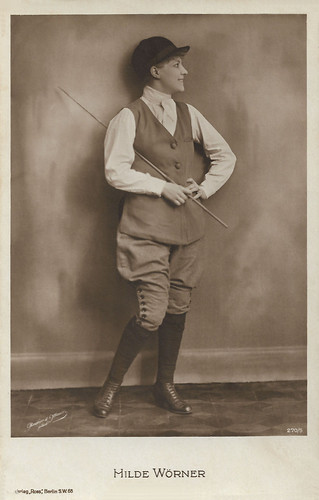
German postcard by Ross Verlag, Berlin, no. 270/5, 1919-1924. Photo: Becker & Maass.

German postcard by Verlag Ross, Berlin, no. 299/2, 1919-1924. Photo: Zander & Labitsch, Berlin.
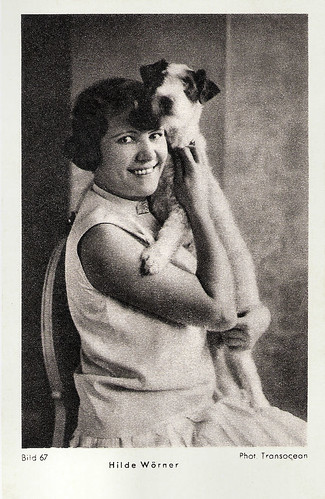
German postcard by Margarinewerk Eidelstedt Gebr. Fauser G.m.b.H., Holstein, Serie 1, no. Bild 67. Photo: Transocean.
Sources: Stephanie D’heil (Steffie-line - German), Nederlands Muziek Instituut (Dutch and German), Wikipedia (German) and IMDb.
No comments:
Post a Comment